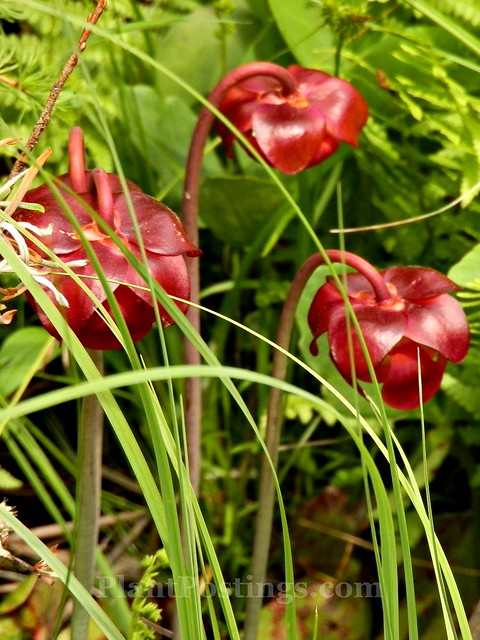
It's Wildflower Wednesday--a meme hosted by Gail at Clay and Limestone on the fourth Wednesday of every month.
This month, I decided to highlight a carnivorous plant--The Purple Pitcher Plant (Sarracenia purpurea). When in bloom, its nodding, burgundy-colored flowers are pretty easy to spot in the wild, although its growing conditions are highly specialized.
This species is widespread throughout Canada, the Northeastern U.S., and in a few spots in the Appalachians and the Coastal Southeast. However, it's most likely to be found in bog habitats--highly acidic, waterlogged peatlands, in old lake basins or depressions. In bogs, there are few or no surface inflows, so they have low rates of decomposition.
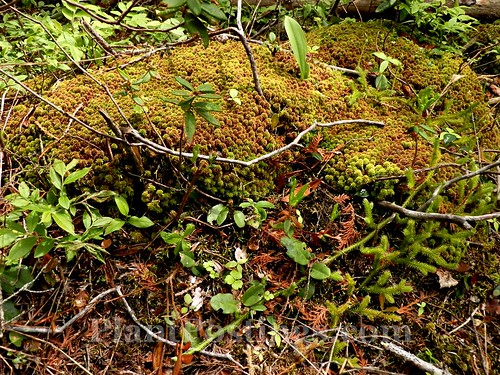
Sphagnum Moss, the dominant living matter, and accumulated peat lying just below the surface, release acids. Often the pH in bogs is as low as 3.0 to 4.0.
In areas where trails lead across bogs, the soil feels bouncy because of the accumulated organic matter and peat.
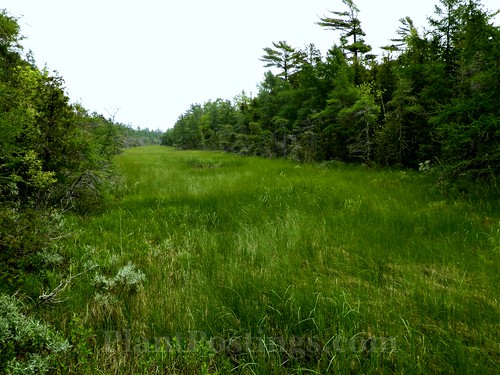
One very special place to experience healthy bog habitats is The Ridges Sanctuary in Door County, Wis., where these photos were taken. At The Ridges, wetland habitats, including marshes, swamps, bogs, and fens (and other habitats) exist in close proximity.
The Ridges, which consists of about 30 narrow, crescent-shaped ridges along the Lake Michigan shoreline, is home to one of the greatest concentrations of rare plants in the Midwest. I posted about one of our trips to The Ridges in 2014.

If you catch sight of the burgundy flowers of the Purple Pitcher Plant, you're probably on or near a bog. The flowers are attractive, but you'll also want to look down.
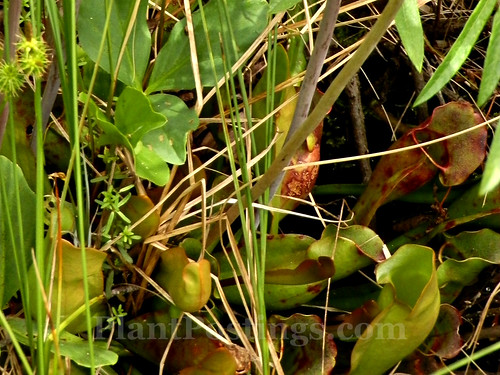
At the base of the stems are the carnivorous leaves of the plant--forming an open, spreading rosette. Sometimes the foliage is tinged with burgundy or purple.
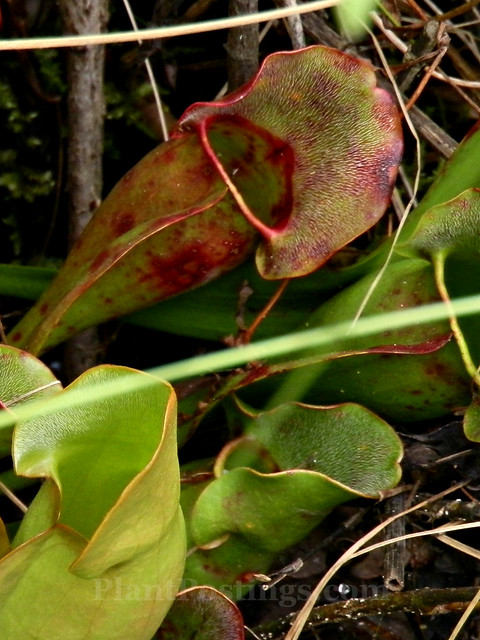
The Purple Pitcher Plant, found in USDA zones 4 to 8, is one of the few carnivorous plants in North America. Its hollow pitchers fill with water, and when flying and crawling insects land on the foliage they can crawl in but may have trouble getting out through the stiff, downward-pointing hairs. Trapped insects that fall into the water are then digested and absorbed by the plant. This provides nutrients to the plant, especially nitrogen, which is in short supply in the highly acidic bog soil.
Because of its specialized needs, Purple Pitcher Plant is best purchased from a reputable nursery, not extracted from the wild. It can be grown as a houseplant in a particular mix of peat moss and perlite. Regular garden or potting soil will kill the plant.
For more information on this unique wildflower plant and its specialized habitat, visit the source links for this post:
- Wisconsin Natural Resources Magazine
- USDA Forest Service
- USDA Northeastern Area State and Private Forestry
- The Ridges Sanctuary
Be sure to visit Gail at Clay and Limestone for posts about other wildflowers from around the world. I'm also linking this post to Dozens for Diana, at Elephant's Eye on False Bay.
The flowers are very pretty. However, this insidious plant attracts insects to have food. Interesting is that our nature. Regards.
ReplyDeleteYes, nature is fascinating, isn't it? Specialized plants amaze me. This plant will not survive in a normal garden, but it thrives in poor soil. Interesting.
DeleteGorgeous photos, Beth. I don't know all that much about the general family(ies) of carnivorous plants, but many seem to be bog-type growers. Thanks for information on this interesting and beautiful plant.
ReplyDeleteThank you, Tina. It's a fun plant to find in the wild. Bogs are fascinating, aren't they?
DeleteFascinating to learn more about these plants Beth. Thank you.
ReplyDeleteYou are welcome. Botany and gardening are life-long learning opportunities, aren't they? There's so much more to learn about every plant. I wish I could keep it all in my head. ;-)
DeleteWow. I thought all carnivorous pitcher plants were tropical! Learned something new today, thanks to you :)
ReplyDeleteYes, I guess most of them are, but not all. I've seen this species in several places in Wisconsin, but it's not common obviously except in its specialized habitat. It's a fun plant to find in the wild.
DeleteWe have a tiny sundew, also found in bogs.
ReplyDeleteSuch a magnificent colour those flowers have!
We have Sundews here, too. Bogs are so interesting. Yes, the color of the flowers is pretty. In bud form, and earlier in the flowering stage, the blooms are a little more subdued.
DeleteThese boggy areas are fascinating to me. There is nothing like them around here. I saw that skunk cabbage is blooming someplace up in northern Indiana. Spring is trying to make its way in.
ReplyDeleteI agree, Lisa. The bogs occur here and there in Wisconsin. Wetlands are so fascinating with their specialized plants and the wildlife they support. I've heard reports of Skunk Cabbage blooming in S. Wisconsin, too. Yay, spring! (A little early, but oh well.)
DeleteWhat a beautiful plant. I really like pitcher plants, but unfortunately there are none (that I'm aware of) that are native to Britain.
ReplyDeleteI'm fascinated by them, too. Such a specialized niche they fill! I suppose places like Kew have pitcher plants in pots? I would never try to grow them in my garden--the soil would kill them. But it's fun to find them in the wild.
DeleteThat's right, a lot of gardens do grow them. Luckily an abbey with a garden that's local to me grow them and I pop in once in a while to look at them. I also came across a garden centre that sells them as indoor plants recently.
DeleteHi Beth,
ReplyDeleteGreat pictures and I love all the information in this post! I will have to look very carefully at the area behind our house that is mucky and wet....maybe there's a a boggy area out there. I would love to see the Pitcher plant out in the wild.
Thanks, Sally. I'm glad you enjoyed it. Ah, that would be fun to live near a bog. My soil here in this part of the state is too fertile. The pitcher plants would be totally out of their element here. But I do enjoy finding them in the wild!
DeleteVery good post Beth. Strangely enough, there are pitcher plants around here (I say strangely because the bogs here are very alkaline (they are fens). I expect there is enough acid rain to create acidic spots where pitcher plants can survive. Ours don't look as lush as in your picture though.
ReplyDeleteThank you, Alain! Fens are interesting, too. In some places here in Wisconsin (including The Ridges), bogs are adjacent to fens and other habitats. Interesting thought about the acid rain. Apparently Purple Pitcher Plants are found throughout the Canadian provinces. :)
DeleteGreat post! Pitcher plants are always fascinating, and I had no idea that Purple Pitcher Plants were so attractive.
ReplyDeleteThanks, Jason. I agree--it's fun to find them during hikes. The flowers at this point in the bloom are attractive and showy. In bud stage and early bloom, the flowers are a little more subdued and darker. But they're beautiful at that stage, too.
DeleteI wish I had a spot to grow pitcher plant where it would be safe from my dogs. My only really super boggy area is routinely run over by the canine crew so I have a lot of acorus there. These are so cool!
ReplyDeleteI suppose your garden soil would kill them before the dogs would even have a chance, since pitcher plants need peat and acid conditions. But they might grow for you in a pot. I don't think I'd want to try it, but they are fun plants.
DeleteI had never heard of them before - the flowers sure are pretty! I doubt we have any around our area as our soil is very alkaline - even growing blueberries is a struggle with your only chance being to replace the existing soil with a peat based mixture.
ReplyDeleteInteresting--I didn't realize your soil was so alkaline. Mine tends slightly toward acidic because of all the slowly decomposing Oak leaves. But it's much too rich for Pitcher Plants. Some folks around here grow blueberries successfully, and they do grow in the wild here. Talk about a fun plant to find along a hike! Fresh blueberries are the best!
Deletethe affinity of carnivorous plants for acidic habitat is fascinating. If I've run into ideas about why, I don't remember. Do you know?
ReplyDeleteHi Hollis: My assumption was that they adapted to fill a niche--less competition in bogs from other plants that need nutrient-rich soils. But then, the why of them needing nutrient-poor soil? And how does fertile soil damage them? A little research reveals that the salts in nutrient-rich soils will burn their roots. Here's a good article about carnivorous plants and their special needs: http://www.reptilesmagazine.com/Carnivorous-Plants-For-Beginners/.
DeleteVery interesting article ... thanks, Beth
DeleteWhat a treat this was Beth as I have never seen this plant's flowers....always see the pitcher later....and I love bogs. I would love to add this to my land, but it just isn't boggy enough....flooded right now but not boggy. I will have to go to our local nature center in early spring and see if I spot these flowers in the bog there.
ReplyDeleteWe were lucky that the plants were at a nice stage of flowering when we were at The Ridges. It made it easier to find the plants, since the foliage was kind of hidden behind some ferns, grasses, and sedges. I'm guessing your soil and your pond are too nutrient-rich for Pitcher Plants, because other plants grow well there. But maybe you have some spots with Sphagnum Moss and decomposing peat? Yes, a bog at the nature center seems like a good place find them. :)
DeleteSuch a fascinating plant, I'd love to see them growing wild like that.
ReplyDeleteYes, it's unique. And it's really fun to find it growing in the wild. It's easier to find when it's blooming.
DeleteI love Pitcher Plants. They're beautiful. The only ones near us are container grown. We aren't boggy here in my neighborhood and the soil is nearly neutral! Happy WW.
ReplyDeleteThanks for hosting, Gail! I think they're wonderful, too. My soil here at home isn't right for Pitcher Plants, either, but they're fun to find while hiking or at a botanical garden. :)
DeleteI have seen these type of plants on plant exhibitions many years ago, I wish I had the right soil for them in my garden – fascinating stuff!
ReplyDeleteYes, my soil isn't right for them either. They're fun to find in the wild, though, and if I had the patience and the space I might think about growing one in a pot.
DeleteI see more of them growing in PA. Wonderful plant. I agree. Don't dig them from the wild.
ReplyDeleteYes, fun plant. Their specific growing conditions would make it near impossible to grow them successfully in normal garden soil. Great to find them during a hike, though.
DeleteHello, gorgeous wildflowers! The moss and bog scene are beautiful. Great post and photos. Have a happy weekend!
ReplyDeleteHi Eileen: Thank you. Yes, it's fun to hike in places with interesting plants and growing conditions. Enjoy the rest of your weekend, too. :)
DeleteGreat post! We're going to Door sometime this summer or fall, so I am adding The Ridges to my must visit list.
ReplyDeleteThanks, Linda. Oh, yes, I think you'd enjoy The Ridges very much! Door County has so much to offer. Great place to explore!
DeleteI didn't know this plant had such pretty flowers! I know now! Thank you Beth!
ReplyDeleteYou're welcome, Tatyana. I think the stage when we saw them is the most vibrant. When they're in bud stage, the flowers aren't quite as showy, but still as beautiful in a different way. :)
DeleteI love Sarracenia, it looks so exotic, and I guess given its feeding habits - it is. At the Lewis Ginter Botanic Garden in Richmond, VA they have wonderful collection with an elevated boardwalk over their bog garden.
ReplyDeleteYes, good point--I guess it is exotic. :) OK, now I have another "must see" botanic garden destination. Thanks!
DeleteI had heard of these particular plants before but knew very little about them. Great read and a wonderful place to be able to visit.
ReplyDeleteYes, The Ridges is an amazing place to visit. If I lived closer, I'd probably be there at least once a week. Thanks, Angie.
DeleteHi,
ReplyDeleteWe stumbled upon this plant during a hike in the Porcupine Mountains, Michigan.
Hi Carla: Nice! That sounds like a great destination, too. I've been in that part of Michigan in winter, but never in summer. Might have to make a trip up there one of these days!
DeleteI first saw the blooms of a pitcher plant when walking in the Garden in the Woods at the New England Wildflower Society headquarters. I was blown away - so cool! The Ridges sounds like such a great conservation spot full of treasures!
ReplyDeleteHi Indie: Oh my, the Garden in the Woods sound like a great destination, too! Thanks for the info. Yes, The Ridges is a very special place. :)
DeleteA fascinating plant, Beth. I didn't realize they were hardy in my zone. P. x
ReplyDeleteYes, Pam. I suppose if you have any bogs near you, you might find them. Cheers!
DeleteThese are very interesting, as well as beautiful plants! When my boys were little, they had a fascination with carnivorous plants. Some do grow here in Alabama.
ReplyDeleteHi Deb: My kids did, too. I can remember going to the botanical garden with them and seeing the carnivorous plants in action. Sarracenia purpurea is native to Alabama. It has such a wide geographical range, but specialized growing conditions.
DeleteI haven't seen yet a flower of a pitcher plant, that one is so lovely though drooping much. We have a few species of pitcher plants endemic here and in garden shows i only see the pitchers.
ReplyDeleteYes, the drooping habit is how they flower naturally, which has a role in its specialized pollination action. This citation has a good description of how it works:
Deletehttp://botany.org/Carnivorous_Plants/Sarracenia.php.
Lovely looking plant, interesting to read..
ReplyDeleteAmanda xx
Thanks, Amanda. Yes, it's a fascinating plant. So many characteristics make it unique--all the info could probably cover several posts. :)
DeleteHow exciting to see pitcher plants in the wild. I knew they were cold hard to some extent because they grow in our mountains but I didn't know they grow in Wisconsin!
ReplyDeleteThe NC Botanical Garden in Chapel Hill has a beautiful collection of pitcher plants and has released some cultivars, but I've never seen them growing in the wild.
Yes, believe it or not, they even grow throughout Canada. Thanks for the info about the NC Botanical Garden. Honestly, that will be on my "must see" list for the future.
DeleteHi Beth, that was a really interesting and informative post to read! I have seen the Purple Pitcher Plant for sale in nurseries, but wasn't aware that they have such lovely flowers as well.
ReplyDeleteI remember hiking through bog areas in Germany and I recall the soft feel of the ground under my feet very vividly. It is really special!
Wishing you a wonderful week, Beth!
Warm regards,
Christina
Hi Christina: Thank you. The flowers were at a really nice stage when we were at The Ridges and the sun was out, but filtered. So it gave the flowers a nice brightness without washing out with reflections. Regarding the spongy feel of the soil--I remember the few times I've experienced it feeling it was a little unsettling, but fun at the same time. I imagine Germany being an amazing country to visit, and I hope to get there someday. :) Enjoy your week, too!
Delete